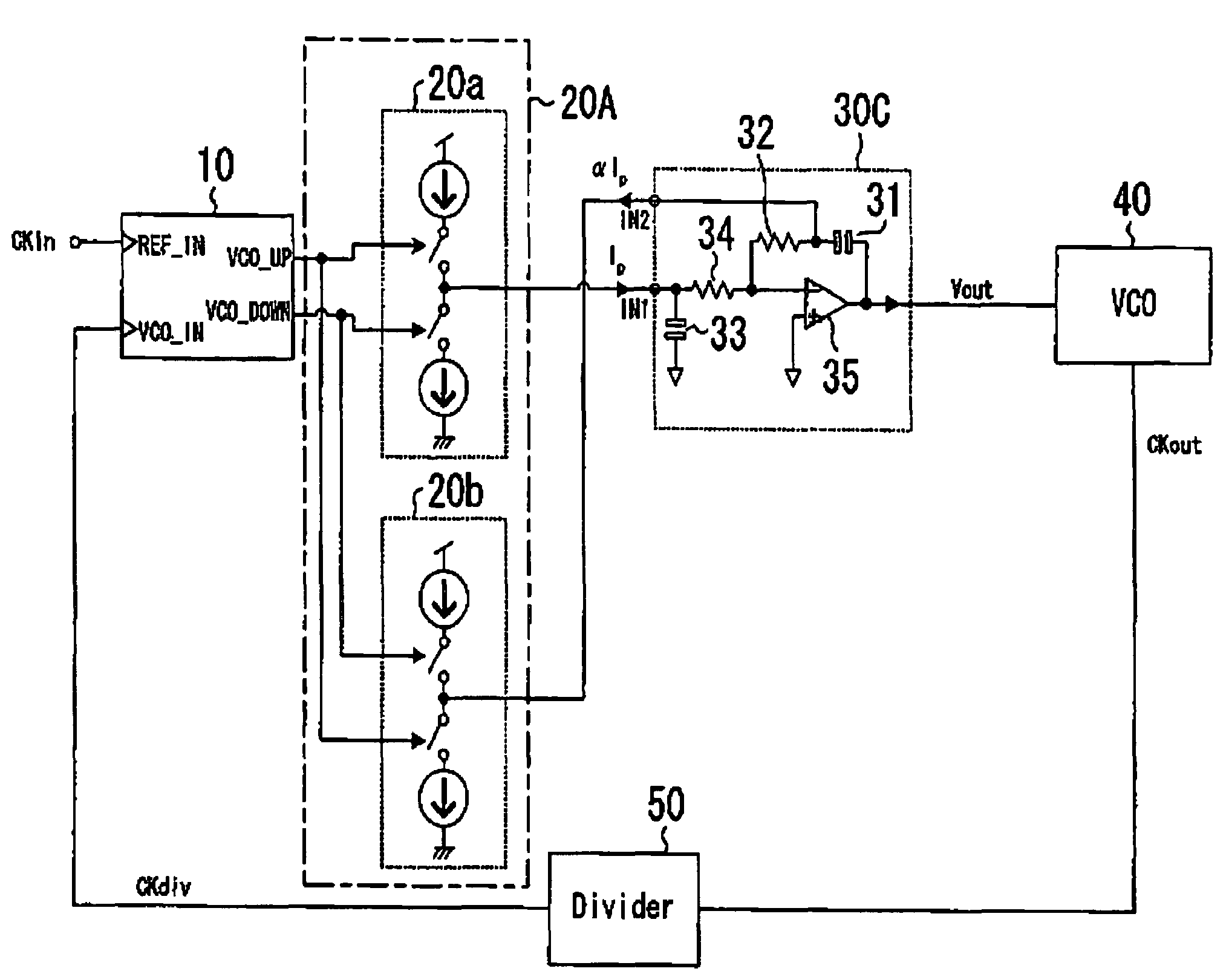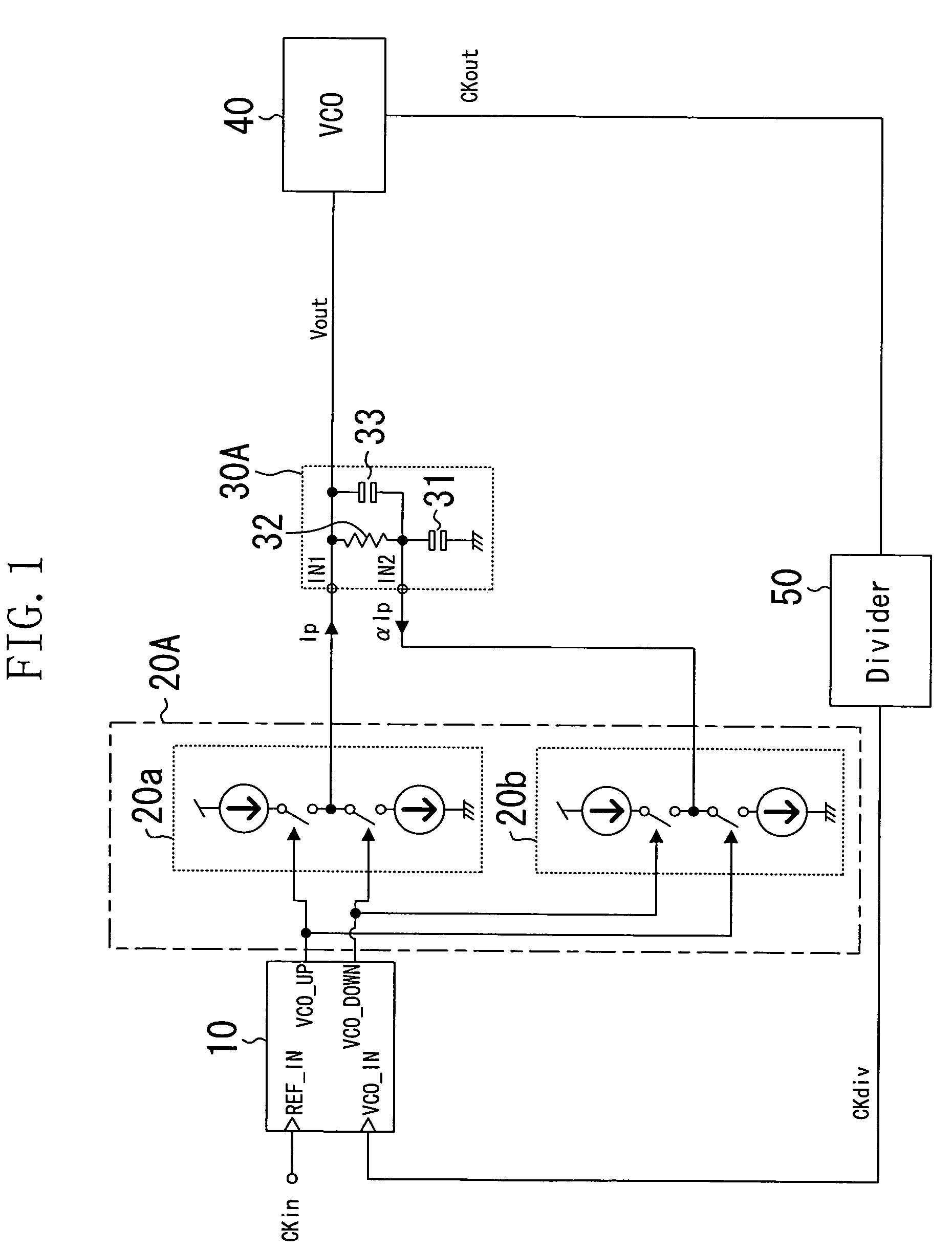Low-pass filter, feedback system, and semiconductor integrated circuit
- Summary
- Abstract
- Description
- Claims
- Application Information
AI Technical Summary
Benefits of technology
Problems solved by technology
Method used
Image
Examples
embodiment 1
[0042]FIG. 1 shows the structure of a feedback system according to embodiment 1 of the present invention. The feedback system of embodiment 1 is a PLL including a phase comparator 10, a charge pump circuit 20A, a loop filter 30A, a voltage controlled oscillator (output clock generation means) 40, and a frequency divider 50. Among these components, the phase comparator 10, the voltage controlled oscillator 40, and the frequency divider 50 are as described above. Hereinafter, the charge pump circuit 20A and the loop filter 30A are described in detail.
[0043]The charge pump circuit 20A includes two general charge pump circuits (partial charge pump circuits) 20a and 20b. The charge pump circuit 20a outputs / receives electric current Ip according to signal UP and signal DN which are output from the phase comparator 10. The charge pump circuit 20b outputs / receives electric current αIp according to signal UP and signal DN. The direction of electric current αIp is opposite to that of electric...
embodiment 2
[0051]FIG. 3 shows the structure of a feedback system according to embodiment 2 of the present invention. The feedback system of embodiment 2 is a PLL including an active loop filter 30C, whereas the feedback system of embodiment 1 is a PLL including the passive loop filter 30A. The components of the PLL of embodiment 2 are as described in embodiment 1 except for the loop filter 30C. Hereinafter, the loop filter 30C is described in detail.
[0052]The loop filter 30C includes a capacitive element (first element block) 31, a resistive element (second element block) 32 connected in series to the capacitive element 31, a capacitive element (third element block) 33, a resistive element 34, and an operational amplifier 35. The output terminal of the operational amplifier 35 is connected to one end of the capacitive element 31. The inverted phase input terminal of the operational amplifier 35 is connected to a connection point of the resistive element 32 and the resistive element 34. The nor...
embodiment 3
[0061]FIG. 6 shows the structure of a feedback system according to embodiment 3 of the present invention. The feedback system of embodiment 3 is a delay locked loop circuit (hereinafter, referred to as “DLL”) including a phase comparator 10, a charge pump circuit 20C, a loop filter 30E, and a voltage controlled delay circuit (output clock generation means) 40. Hereinafter, the charge pump circuit 20C and the loop filter 30E are described in detail.
[0062]The charge pump circuit 20C includes current sources 21 and 23 for charge, which supply electric currents αIp and (1−α)Ip, respectively, and current sources 22 and 24 for discharge as does the above-described charge pump circuit 20B. When signal UP is supplied, control switches SW1 and SW3 are brought into conduction so that electric currents αIp and (1−α)Ip are released. On the other hand, when signal DN is supplied, control switches SW2 and SW4 are brought into conduction so that electric currents αIp and (1−α)Ip are sucked. That i...
PUM
 Login to View More
Login to View More Abstract
Description
Claims
Application Information
 Login to View More
Login to View More - R&D
- Intellectual Property
- Life Sciences
- Materials
- Tech Scout
- Unparalleled Data Quality
- Higher Quality Content
- 60% Fewer Hallucinations
Browse by: Latest US Patents, China's latest patents, Technical Efficacy Thesaurus, Application Domain, Technology Topic, Popular Technical Reports.
© 2025 PatSnap. All rights reserved.Legal|Privacy policy|Modern Slavery Act Transparency Statement|Sitemap|About US| Contact US: help@patsnap.com



